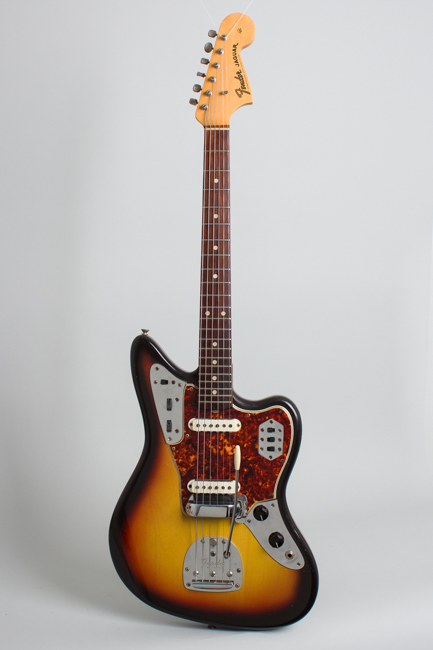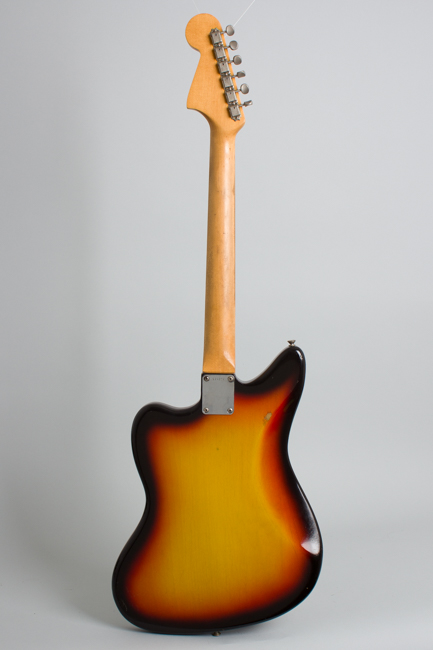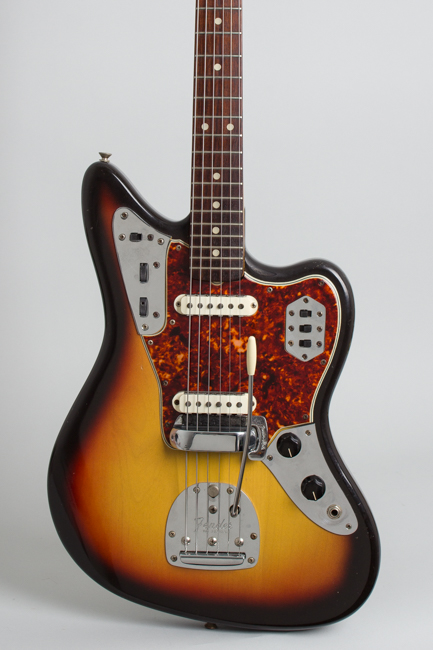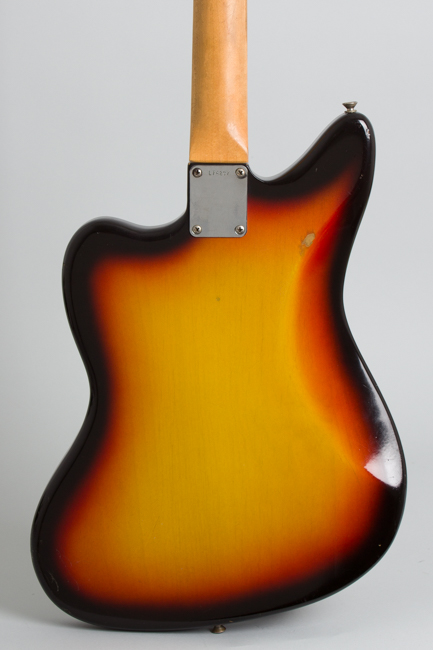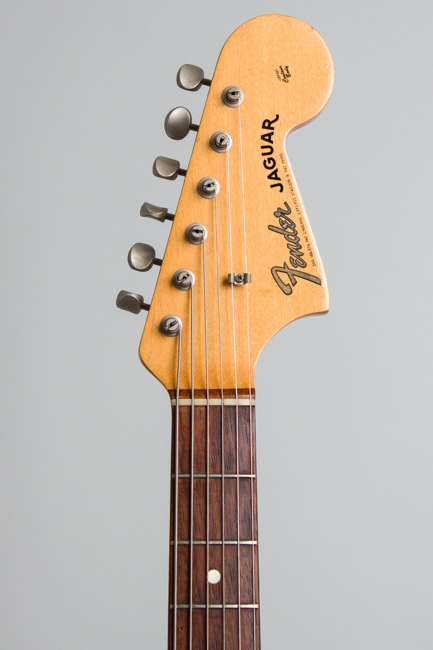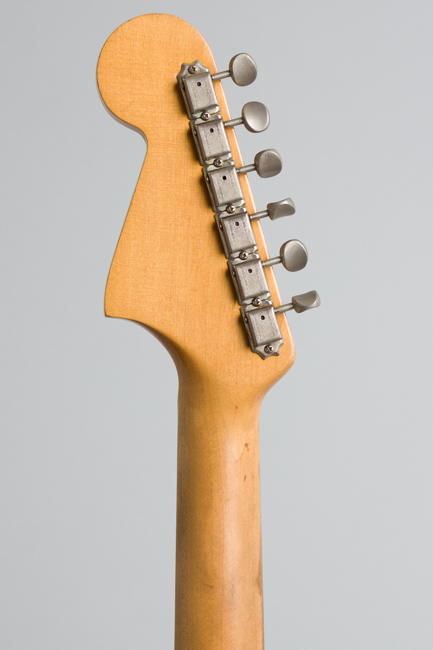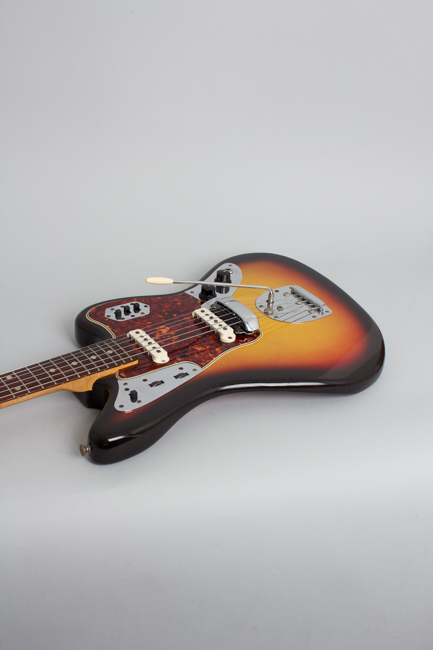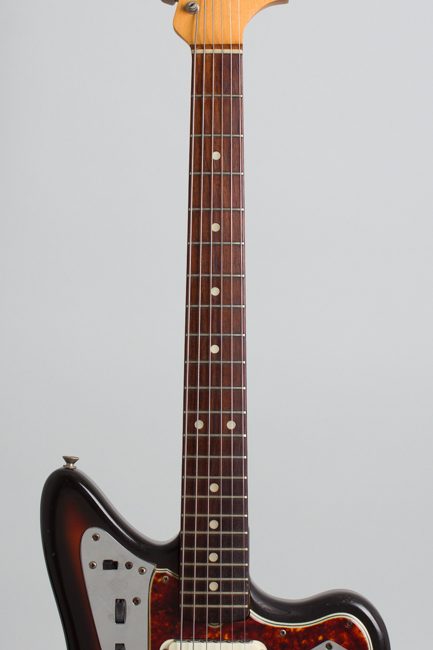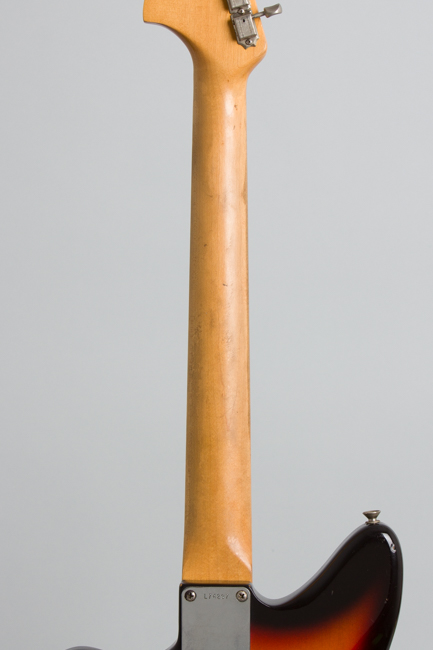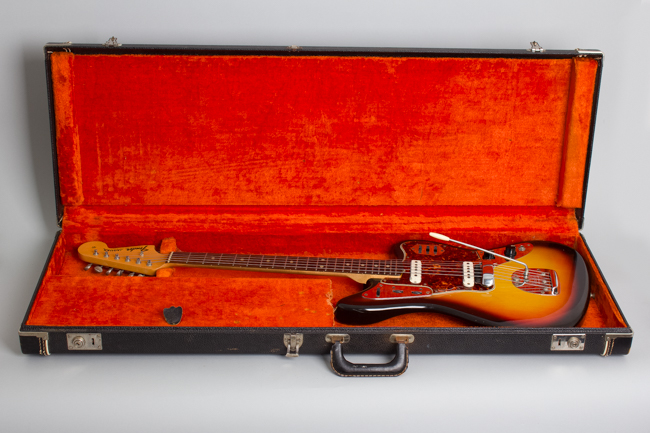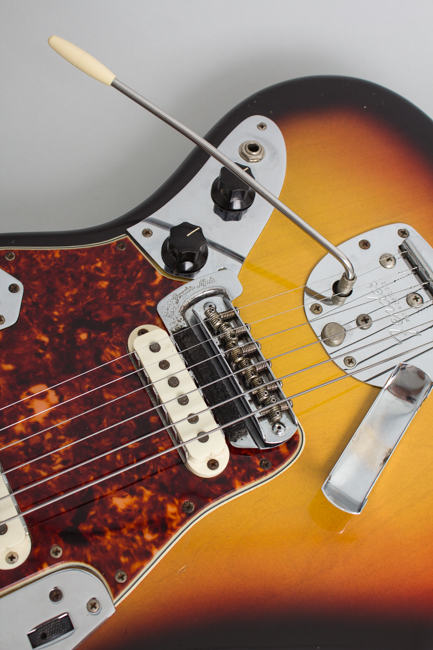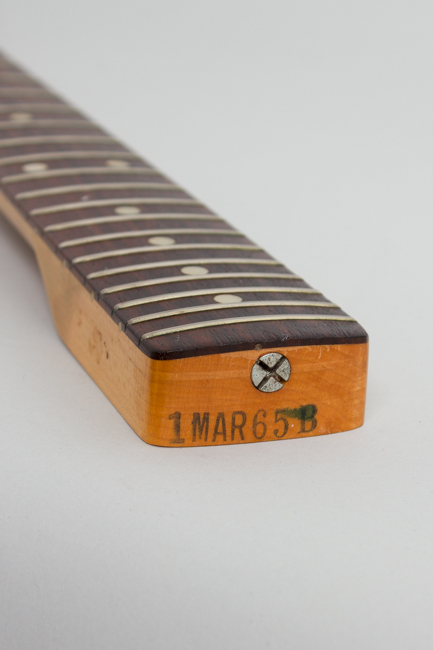Fender Jaguar Solid Body Electric Guitar (1965)
This item has been sold.
Item # 12363
Prices subject to change without notice.
Fender Jaguar Model Solid Body Electric Guitar (1965), made in Fullerton, California, serial # L74297, sunburst lacquer finish, alder body, maple neck with rosewood fingerboard, original black tolex hard shell case.
This is a very clean and all-original example of an early CBS-era Jaguar, showing some minor wear but in fine playing and completely unaltered condition. It was built just a few months after the Fender sell-out to CBS in January 1965; the stamped neck date is MAR 65, and the pots date to the 8th week of that year. Typical early 1965 features include an unbound fingerboard with pearloid dot inlay, bright "target" 3-color sunburst lacquer finish on the body and the gold transition logo headstock decal. The pickguard is the new-for-65 ABS laminated tortoise pattern plastic that had just replaced the older Nitrocellulose piece.
The Jaguar debuted in spring 1962 as Fender's new top-of-the line guitar, supplanting the Jazzmaster. The shorter scale and flashy chrome-accented look quickly made it a status symbol for many combos in the early '60s, not only California teen bands but also country players and even many Chitlin' Circuit R&B acts.
Even having recently undergone a revival of sorts, the Jaguar remains one of the more under-appreciated of vintage guitars with several interesting features. The scale length is shorter than other professional-grade Fender guitars at 24", designed to enhance playability. The guitar is very supple to play but performs better with heavier gauge strings. The two-circuit wiring and floating vibrato are shared with the Jaguar's ancestor, the Jazzmaster, but the guitar actually feels quite different. While the tremolo unit itself is the same as the Jazzmaster, the lower string tension of the shorter scale gives it more range.
The pickup selection is controlled by a bank of slide switches on the treble side; each pickup has an on/off switch, while the third is a "strangle" switch that cuts lower frequencies. The rhythm circuit works as on the Jazzmaster, giving a quickly selectable deeper toned neck pickup. This all combines to make the "Jag" a very flexible guitar with a lot of sonic options.
The unique Jaguar pickups with the chrome-plated "claw" baseplate are optimized for punch, clarity and crispness, factors that led to the model losing popularity in the late '60s as twang went out and crunch and heavy distortion came in! Nevertheless, these top-of-the line '60s Jaguars are very high quality guitars, still a relative bargain in a 1960s Fender instrument. The once-ignored Jag has found an appreciative new audience over the last couple of decades, and the Twang of the ages lives on!
Overall length is 40 in. (101.6 cm.), 14 in. (35.6 cm.) wide at lower bout, and 1 5/8 in. (4.1 cm.) in depth, measured at side of rim. Scale length is 24 in. (610 mm.). Width of nut is 1 5/8 in. (41 mm.).
This is a lovely guitar overall, all original showing just some typical light wear but nothing too serious. The body finish shows very little checking and some fade to the bright "target" sunburst. There is not too much in the way of actual play wear, mostly just small dings, scratches and dents scattered around. There is a small spot of buckle wear through the finish to the back and one rubbed away spot in the cutaway where somebody either strummed heartily or went for the high notes a lot. There is also wear to the wood along the back of the neck (more heavily along the upper edge) giving it that glorious "worn-in Fender" feel. The fretboard has a little "strum wear" at the body end.
All hardware is original and complete, including the trem arm, snap-on bridge cover and mute, which is functional but the original foam has hardened to resemble 55 year old chewing gum. This can be replaced if desired. The original factory shims are still in the neck pocket. The original small frets have some light wear but still play well. The is a delightful unaltered survivor of the mid-60s and a great-sounding transitional Jaguar, still housed in the relatively clean original first-generation black Telex red-lined "no-logo" Fender case. Overall Excellent - Condition.
This is a very clean and all-original example of an early CBS-era Jaguar, showing some minor wear but in fine playing and completely unaltered condition. It was built just a few months after the Fender sell-out to CBS in January 1965; the stamped neck date is MAR 65, and the pots date to the 8th week of that year. Typical early 1965 features include an unbound fingerboard with pearloid dot inlay, bright "target" 3-color sunburst lacquer finish on the body and the gold transition logo headstock decal. The pickguard is the new-for-65 ABS laminated tortoise pattern plastic that had just replaced the older Nitrocellulose piece.
The Jaguar debuted in spring 1962 as Fender's new top-of-the line guitar, supplanting the Jazzmaster. The shorter scale and flashy chrome-accented look quickly made it a status symbol for many combos in the early '60s, not only California teen bands but also country players and even many Chitlin' Circuit R&B acts.
Even having recently undergone a revival of sorts, the Jaguar remains one of the more under-appreciated of vintage guitars with several interesting features. The scale length is shorter than other professional-grade Fender guitars at 24", designed to enhance playability. The guitar is very supple to play but performs better with heavier gauge strings. The two-circuit wiring and floating vibrato are shared with the Jaguar's ancestor, the Jazzmaster, but the guitar actually feels quite different. While the tremolo unit itself is the same as the Jazzmaster, the lower string tension of the shorter scale gives it more range.
The pickup selection is controlled by a bank of slide switches on the treble side; each pickup has an on/off switch, while the third is a "strangle" switch that cuts lower frequencies. The rhythm circuit works as on the Jazzmaster, giving a quickly selectable deeper toned neck pickup. This all combines to make the "Jag" a very flexible guitar with a lot of sonic options.
The unique Jaguar pickups with the chrome-plated "claw" baseplate are optimized for punch, clarity and crispness, factors that led to the model losing popularity in the late '60s as twang went out and crunch and heavy distortion came in! Nevertheless, these top-of-the line '60s Jaguars are very high quality guitars, still a relative bargain in a 1960s Fender instrument. The once-ignored Jag has found an appreciative new audience over the last couple of decades, and the Twang of the ages lives on!
Overall length is 40 in. (101.6 cm.), 14 in. (35.6 cm.) wide at lower bout, and 1 5/8 in. (4.1 cm.) in depth, measured at side of rim. Scale length is 24 in. (610 mm.). Width of nut is 1 5/8 in. (41 mm.).
This is a lovely guitar overall, all original showing just some typical light wear but nothing too serious. The body finish shows very little checking and some fade to the bright "target" sunburst. There is not too much in the way of actual play wear, mostly just small dings, scratches and dents scattered around. There is a small spot of buckle wear through the finish to the back and one rubbed away spot in the cutaway where somebody either strummed heartily or went for the high notes a lot. There is also wear to the wood along the back of the neck (more heavily along the upper edge) giving it that glorious "worn-in Fender" feel. The fretboard has a little "strum wear" at the body end.
All hardware is original and complete, including the trem arm, snap-on bridge cover and mute, which is functional but the original foam has hardened to resemble 55 year old chewing gum. This can be replaced if desired. The original factory shims are still in the neck pocket. The original small frets have some light wear but still play well. The is a delightful unaltered survivor of the mid-60s and a great-sounding transitional Jaguar, still housed in the relatively clean original first-generation black Telex red-lined "no-logo" Fender case. Overall Excellent - Condition.
